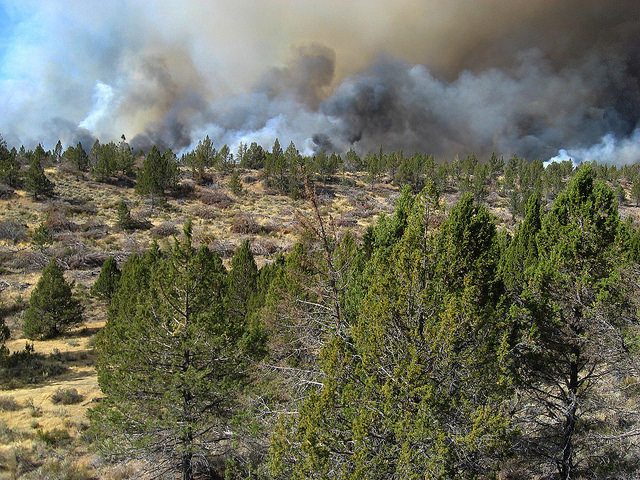 Flickr user: Bureau of Public Management
Flickr user: Bureau of Public Management
America the Resilient
Co-authored by BGen. Stephen A Cheney and Dante Disparte
The United States and indeed the world are entering a period of great turbulence with unforeseen consequences at every turn and cascading events at every failure to anticipate risk and pre-invest in resilience. Resilience as a national priority is defined by the ability to withstand and spring back from shock events and attritional losses. Our oceans no longer shield us from distant enemies and the days of Fortress America have been replaced by vulnerability to global shocks and insidious threats of the man-made, natural and emerging variety. A mere mosquito bite half a world away and a wayward traveler imports the next human pandemic. Our policymakers, political, military and business leaders can no longer debate or search for causality for these grave changes, we must now respond to their impacts and do so in a concerted, collaborative and urgent way. The role of the private sector in building a resilient society is as stark as it was during the industrial revolution.
30 years ago, when black swans (large scale risks) were still rare enough for us to ignore them, it made sense for our counties, cities and states to pick up the pieces, dust themselves off and rely on Federal disaster assistance to rebuild. Today, with sovereign debt presenting an emerging threat to national security, black swans are not only increasingly commonplace, they appear to be flocking around our country and coming home to roost. Boston’s record shattering snow fall, California’s perennial dry spell, wildfires and noxious methane leaks that displaced thousands of Los Angelinos, are but a few recent examples of the convergence of man-made and natural risks. We have not only reached a tipping point, we are sliding off the other side. Katrina, Irene, Sandy and, more recently Patricia, the most powerful hurricane ever recorded, have set their sights on iconic U.S. cities. The internally displaced people (IDPs) from the Gulf region and New Orleans in particular, remind us that large scale human resettlement is no longer the scourge of developing countries, but a part of our reality in the U.S. and something for which we are emotionally and materially unprepared.
Sadly, a platform based on long term resilience will not get a politician elected in our times of gridlock and internecine fighting. Yet, resilience is the key issue defining our future and something each citizen must demand of their elected officials. Each entrepreneur and business leader should set their ingenuity free with resilience as their market focus. The water crisis in Flint Michigan underscores just how fragile we are and supports the argument that resilience must become an investment-grade asset class. Resilience on the vast scale required in the U.S. can be measured as an investment opportunity in the sum total of our human, physical, response and technological systems. In order for this asset class to emerge, the traditional investment horizon needs to be stretched much further than 5 or 10 years and go well into 30, 50 and 100 year spans. Resilience is an investment in which the investor may not be around to enjoy the returns, but there is no other asset class based on so much certainty. Our world is changing and we must invest trillions in being prepared – no sector has this purchasing power and patience like large pension funds, hedge funds and insurers.
Unfunded losses that are passed on to the Federal and state balance sheet through agencies like FEMA, the CDC or the military are not sustainable in the long run. In a resilient society, these vital agencies would be the suppliers of last resort and not the first responders – after all, these are often the costliest interventions we have when combating a crisis. Some crises, like the Great Blackout of 2003, which sent 55 million people in the Northeast and Canada into darkness are so insidious they are triggered by tree branches touching high tension power lines in Ohio. Sending the Army Corps of Engineers to prune trees along the U.S. electrical grid is a costly proposition that comes at the price of our global security posture, even though they would get the job done. Instead of waiting on the sidelines and responding to and funding shocks as they emerge, we must begin to anticipate and prefund them along the entire spectrum of risks one county and city at a time until we have a tightly woven resilient fabric protecting our society. From this platform of endurance, we can continue to lead global efforts having pioneered the new industries and methods for human adaptation.
The central question of building a resilient society is not one we are accustomed to asking – namely, who pays for it? In seeking answers, we came across the Lloyd’s City Risk Index a scholarly work in conjunction with Cambridge University. It provides a measured framework for quantifying the economic value at risk in 301 cities around the world comprising more than 50% of global GDP, including 29 cities in the U.S. In all, there is $7.33 trillion of economic output at risk in North American cities to 18 man-made, natural and emerging threats. Behind these figures, countless lives and livelihoods are at stake. Resilience is the challenge of our time and an asset class worth investing in – doing so requires mobilizing all stakeholders to get off the sidelines and begin demanding long term change and investment.
BGen Stephen Cheney USMC (Ret) was the former Inspector General of the Marine Corps and now serves as the CEO of the D.C. think tank American Security Project.
Dante Disparte is the founder and CEO of Risk Cooperative. He chairs the Business Council for American Security with the American Security Project and is the Co-author of “Global Risk Agility and Decision Making” (Macmillan 2016).






